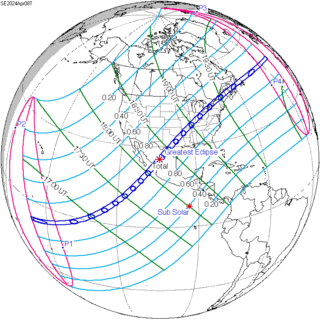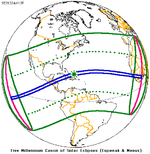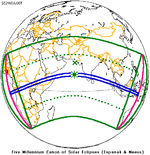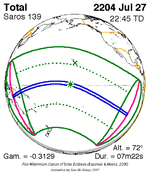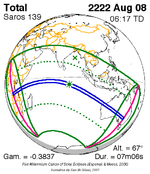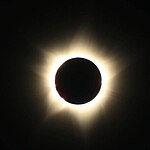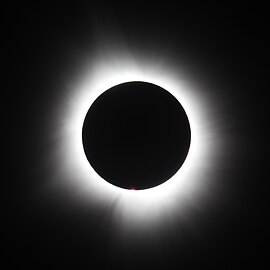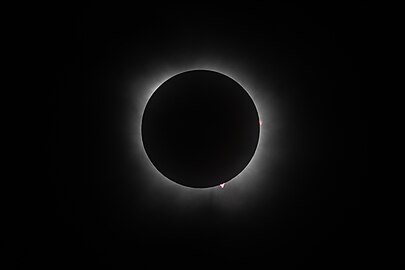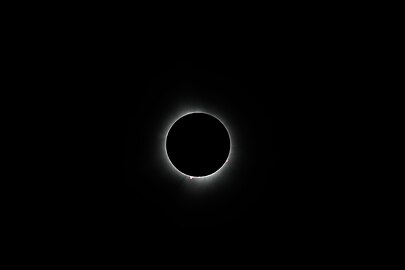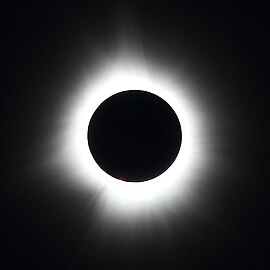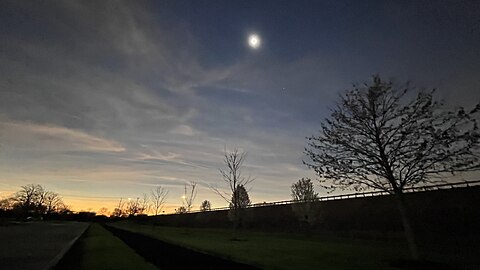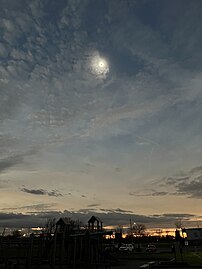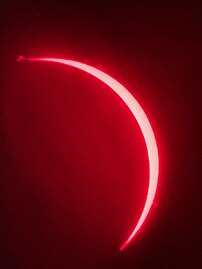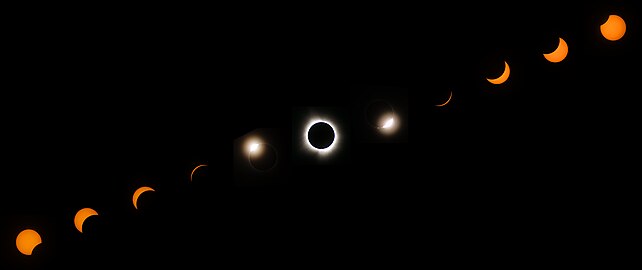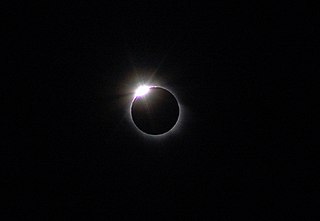
A total solar eclipse occurred on March 29, 2006. A solar eclipse occurs when the Moon passes between Earth and the Sun, thereby totally or partly obscuring the image of the Sun for a viewer on Earth. A total solar eclipse occurs when the Moon's apparent diameter is larger than the Sun's, blocking all direct sunlight, turning day into darkness. Totality occurs in a narrow path across Earth's surface, with the partial solar eclipse visible over a surrounding region thousands of kilometres wide. It was visible from a narrow corridor which traversed half the Earth. The magnitude, that is, the ratio between the apparent sizes of the Moon and that of the Sun, was 1.052, and it was part of Saros 139.

The solar eclipse of August 21, 2017, dubbed the "Great American Eclipse" by some media, was a total solar eclipse visible within a band that spanned the contiguous United States from the Pacific to the Atlantic coasts. It was also visible as a partial solar eclipse from as far north as Nunavut in northern Canada to as far south as northern South America. In northwestern Europe and Africa, it was partially visible in the late evening. In northeastern Asia, it was partially visible at sunrise.

A solar eclipse occurs when the Moon passes between Earth and the Sun, thereby obscuring the view of the Sun from a small part of Earth, totally or partially. Such an alignment occurs approximately every six months, during the eclipse season in its new moon phase, when the Moon's orbital plane is closest to the plane of Earth's orbit. In a total eclipse, the disk of the Sun is fully obscured by the Moon. In partial and annular eclipses, only part of the Sun is obscured. Unlike a lunar eclipse, which may be viewed from anywhere on the night side of Earth, a solar eclipse can only be viewed from a relatively small area of the world. As such, although total solar eclipses occur somewhere on Earth every 18 months on average, they recur at any given place only once every 360 to 410 years.

A total lunar eclipse occurred from 5:27 to 11:06 UTC on 21 December 2010, coinciding with the date of the Winter solstice in the Northern Hemisphere and Summer solstice in the Southern Hemisphere. It was visible in its entirety as a total lunar eclipse in North and South America, Iceland, Ireland, Britain and northern Scandinavia.
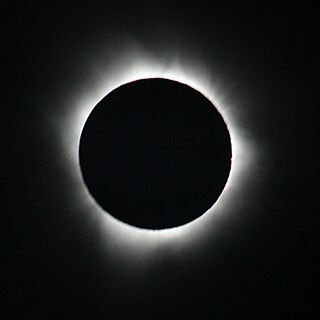
The total solar eclipse of July 11, 2010 occurred over the southern Pacific Ocean. A solar eclipse occurs when the Moon passes between Earth and the Sun, thereby totally or partly obscuring the image of the Sun for a viewer on Earth. A total solar eclipse occurs when the Moon's apparent diameter is larger than the Sun's, blocking all direct sunlight, turning day into darkness. Totality occurs in a narrow path across Earth's surface, with the partial solar eclipse visible over a surrounding region thousands of kilometres wide.

A total solar eclipse occurred at the Moon's descending node of the orbit on August 1, 2008. A solar eclipse occurs when the Moon passes between Earth and the Sun, thereby totally or partly obscuring the image of the Sun for a viewer on Earth. A total solar eclipse occurs when the Moon's apparent diameter is larger than the Sun's, blocking all direct sunlight, turning day into darkness. Totality occurs in a narrow path across Earth's surface, with the partial solar eclipse visible over a surrounding region thousands of kilometres wide. It had a magnitude of 1.0394 that was visible from a narrow corridor through northern Canada (Nunavut), Greenland, central Russia, eastern Kazakhstan, western Mongolia and China. Visible north of the Arctic Circle, it belonged to the so-called midnight sun eclipses. The largest city in its path was Novosibirsk in Russia. The eclipse happened only 2+1⁄2 days after the perigee that occurred on July 29, 2008, and the Moon's apparent diameter was larger than average.
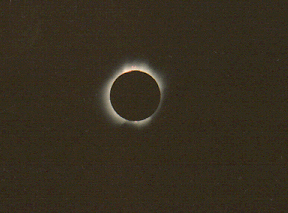
A total solar eclipse occurred at the Moon’s descending node of the orbit on Thursday, July 11, 1991. A solar eclipse occurs when the Moon passes between Earth and the Sun, thereby totally or partly obscuring the image of the Sun for a viewer on Earth. A total solar eclipse occurs when the Moon's apparent diameter is larger than the Sun's, blocking all direct sunlight, turning day into darkness. Totality occurs in a narrow path across Earth's surface, with the partial solar eclipse visible over a surrounding region thousands of kilometres wide. Totality began over the Pacific Ocean and Hawaii moving across Mexico, down through Central America and across South America ending over Brazil. It lasted for 6 minutes and 53.08 seconds at the point of maximum eclipse. There will not be a longer total eclipse until June 13, 2132. This was the largest total solar eclipse of Solar Saros series 136, because eclipse magnitude was 1.07997.
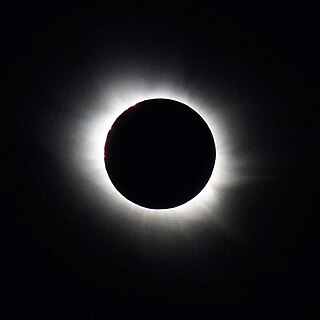
A total solar eclipse occurred on March 20, 2015. A solar eclipse occurs when the Moon passes between Earth and the Sun, thereby totally or partly obscuring the image of the Sun for a viewer on Earth. A total solar eclipse occurs when the Moon's apparent diameter is larger than the Sun's, blocking all direct sunlight, turning day into darkness. Totality occurs in a narrow path across Earth's surface, with a partial solar eclipse visible over a surrounding region thousands of kilometres wide. This total solar eclipse is notable in that the path of totality passed over the North Pole. Totality was visible in the Faroe Islands and Svalbard.

A total solar eclipse occurred on Monday, July 10, 1972. A solar eclipse occurs when the Moon passes between Earth and the Sun, thereby totally or partly obscuring the image of the Sun for a viewer on Earth. A total solar eclipse occurs when the Moon's apparent diameter is larger than the Sun's, blocking all direct sunlight, turning day into darkness. Totality occurs in a narrow path across Earth's surface, with the partial solar eclipse visible over a surrounding region thousands of kilometres wide. Occurring only 2.9 days after perigee, the Moon's diameter was relatively large.
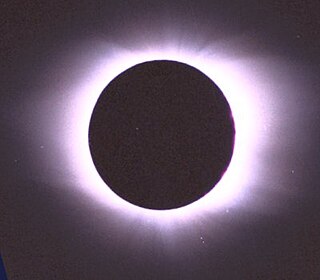
A total solar eclipse occurred at the Moon’s descending node of the orbit on Thursday, February 26, 1998. A solar eclipse occurs when the Moon passes between Earth and the Sun, thereby totally or partly obscuring the image of the Sun for a viewer on Earth. A total solar eclipse occurs when the Moon's apparent diameter is larger than the Sun's, blocking all direct sunlight, turning day into darkness. Totality occurs in a narrow path across Earth's surface, with the partial solar eclipse visible over a surrounding region thousands of kilometres wide. Totality was visible in the Galápagos Islands, Panama, Colombia, the Paraguaná Peninsula in northwestern Venezuela, all of Aruba, most of Curaçao and the northwestern tip of Bonaire, all of Montserrat, Guadeloupe and Antigua and Barbuda.
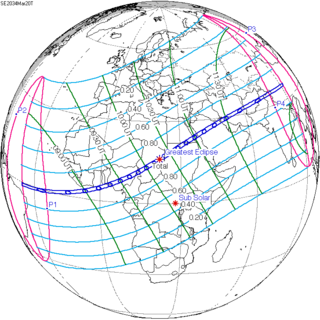
A total solar eclipse will occur on Monday, March 20, 2034. Totality will be visible in 13 countries: from east to west, Benin, Nigeria, Cameroon, Chad, Sudan, Egypt, Saudi Arabia, Kuwait, Iran, Afghanistan, Pakistan, India, and China.
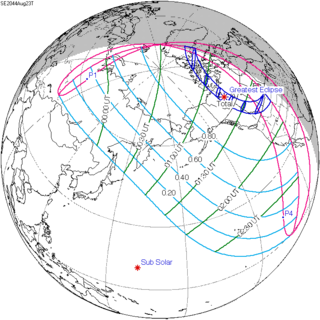
A total solar eclipse will occur on Monday, August 22, 2044. A solar eclipse occurs when the Moon passes between Earth and the Sun, thereby totally or partly obscuring the image of the Sun for a viewer on Earth. A total solar eclipse occurs when the Moon's apparent diameter is larger than the Sun's, blocking all direct sunlight, turning day into darkness. Totality occurs in a narrow path across Earth's surface, with the partial solar eclipse visible over a surrounding region thousands of miles wide.

A total solar eclipse will occur over much of the central Eastern Hemisphere on Monday, August 2, 2027. A solar eclipse occurs when the Moon passes between Earth and the Sun, thereby totally or partly obscuring the image of the Sun for a viewer on Earth. A total solar eclipse occurs when the Moon's apparent diameter is larger than the Sun's, blocking all direct sunlight, turning day into darkness. Totality occurs in a narrow path across Earth's surface, with the partial solar eclipse visible over a surrounding region thousands of kilometres wide.
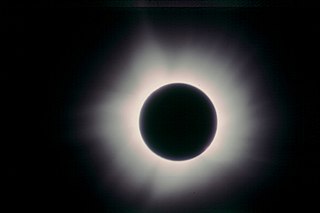
A total solar eclipse occurred on Saturday, March 7, 1970, visible across most of North America and Central America.

A total solar eclipse occurred on October 24, 1995. A solar eclipse occurs when the Moon passes between Earth and the Sun, thereby totally or partly obscuring the image of the Sun for a viewer on Earth. A total solar eclipse occurs when the Moon's apparent diameter is larger than the Sun's, blocking all direct sunlight, turning day into darkness. Totality occurs in a narrow path across Earth's surface, with the partial solar eclipse visible over a surrounding region thousands of kilometres wide. The path of totality went through Iran, Afghanistan, Pakistan, India, southwestern tip of Bangladesh, Burma, Thailand, Cambodia, Vietnam, Spratly Islands, northeastern tip of Sabah of Malaysia, Philippines and Indonesia.

A total solar eclipse will occur on Monday, November 25, 2030. Totality will be visible in Namibia, Botswana, South Africa, Lesotho, and Australia.
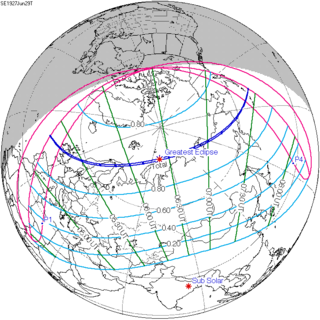
A total solar eclipse occurred on June 29, 1927. A solar eclipse occurs when the Moon passes between Earth and the Sun, thereby totally or partly obscuring the image of the Sun for a viewer on Earth. A total solar eclipse occurs when the Moon's apparent diameter is larger than the Sun's, blocking all direct sunlight, turning day into darkness. Totality occurs in a narrow path across Earth's surface, with the partial solar eclipse visible over a surrounding region thousands of kilometres wide. The path of totality crossed far northern Europe and Asia, including the United Kingdom, Norway, Sweden, Finland and Soviet Union on June 29 (Wednesday), and finally passed Amukta in Alaska on June 28 (Tuesday).
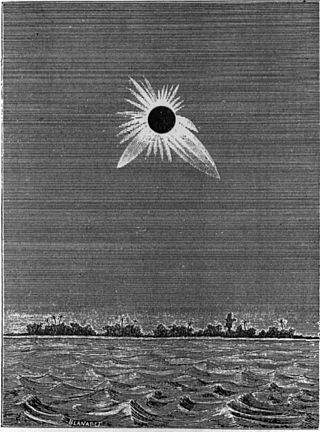
A total solar eclipse occurred on May 6, 1883. A solar eclipse occurs when the Moon passes between Earth and the Sun, thereby totally or partly obscuring the image of the Sun for a viewer on Earth. A total solar eclipse occurs when the Moon's apparent diameter is larger than the Sun's, blocking all direct sunlight, turning day into darkness. Totality occurs in a narrow path across Earth's surface, with the partial solar eclipse visible over a surrounding region thousands of kilometres wide. The path of totality fell across the southern Pacific Ocean with no major landfall. Partiality was visible from far eastern Australia at sunrise, and New Zealand, as well as western South America and southern Mexico near sunset. This eclipse is a member of Solar Saros 136, and its maximum duration was 5 minutes and 58.24 seconds.
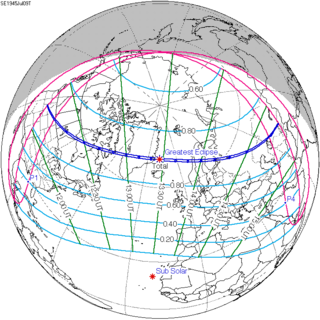
A total solar eclipse occurred on July 9, 1945. A solar eclipse occurs when the Moon passes between Earth and the Sun, thereby totally or partly obscuring the image of the Sun for a viewer on Earth. A total solar eclipse occurs when the Moon's apparent diameter is larger than the Sun's, blocking all direct sunlight, turning day into darkness. Totality occurs in a narrow path across Earth's surface, with the partial solar eclipse visible over a surrounding region thousands of kilometres wide. The path of totality crossed northern North America, across Greenland and into Scandinavia, the western Soviet Union, and central Asia.

